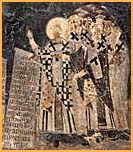|
The theological debates for the
orthodox doctrine
As Christian intellectuals sought to establish
a doctrine f or
the new religion, their varying interpretations gave rise
to ardent theological debates. These were often fuelled by
more earthly considerations, such as the control of large
communities of worshippers and ecclesiastical estate, or the
hierarchy between the patriarchal seats of Rome, Constantinople,
Alexandria, Antioch and Jerusalem. Theological debates occasionaly
acquired political significance, because of their large following
in certain provinces:
Arianism was
widely spread in the barbaric Christian west, while
Monophysitism, found its main support in the Syriac- and Coptic-speaking
east. or
the new religion, their varying interpretations gave rise
to ardent theological debates. These were often fuelled by
more earthly considerations, such as the control of large
communities of worshippers and ecclesiastical estate, or the
hierarchy between the patriarchal seats of Rome, Constantinople,
Alexandria, Antioch and Jerusalem. Theological debates occasionaly
acquired political significance, because of their large following
in certain provinces:
Arianism was
widely spread in the barbaric Christian west, while
Monophysitism, found its main support in the Syriac- and Coptic-speaking
east.
In an attempt to maintain the unity of the Church and
its close relation to the State, the Early Byzantine emperors
conveyed a series of ecumenical councils, which sought to
define a single orthodox faith. The first Ecumenical Council,
held in Nicaea (325), condemned Arianism, a theory which argued
against the divine nature of Christ, and established his dual
(both human and divine) nature. The second Council, held in
Constantinople (381), introduced the concept of the Trinity
- Father, Son and Holy Spirit - three aspects of a single
divinity. The third Council (Ephesus, 431) condemned
Nestorianism,
and acknowledged the Virgin Mary as Mother of God. (Nestorianism
held the Virgin Mary as being simply the Mother of Christ,
because of her son's human nature.) The fourth Council, held
at Chalcedon (451), defined the single nature of Christ as
embracing both the human and the divine, indivisibly but without
confusion. It condemned Monophysitism, according to which
Christ had a single divine nature. A fifth ecumenical council,
conveyed by Justinian (Constantinople, 553), sought, unsuccessfully,
to reconcile the orthodox and the Monophysites.
|